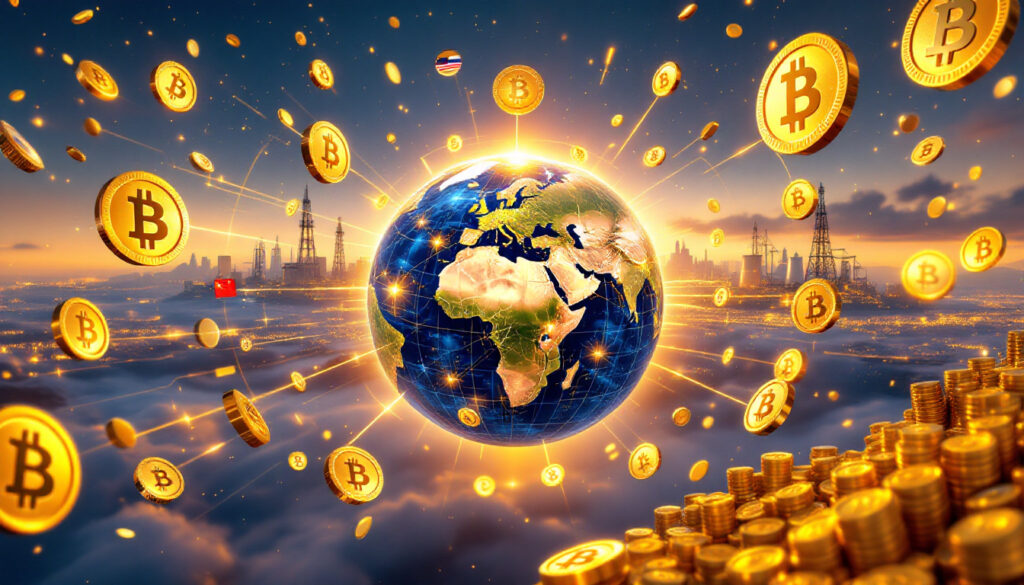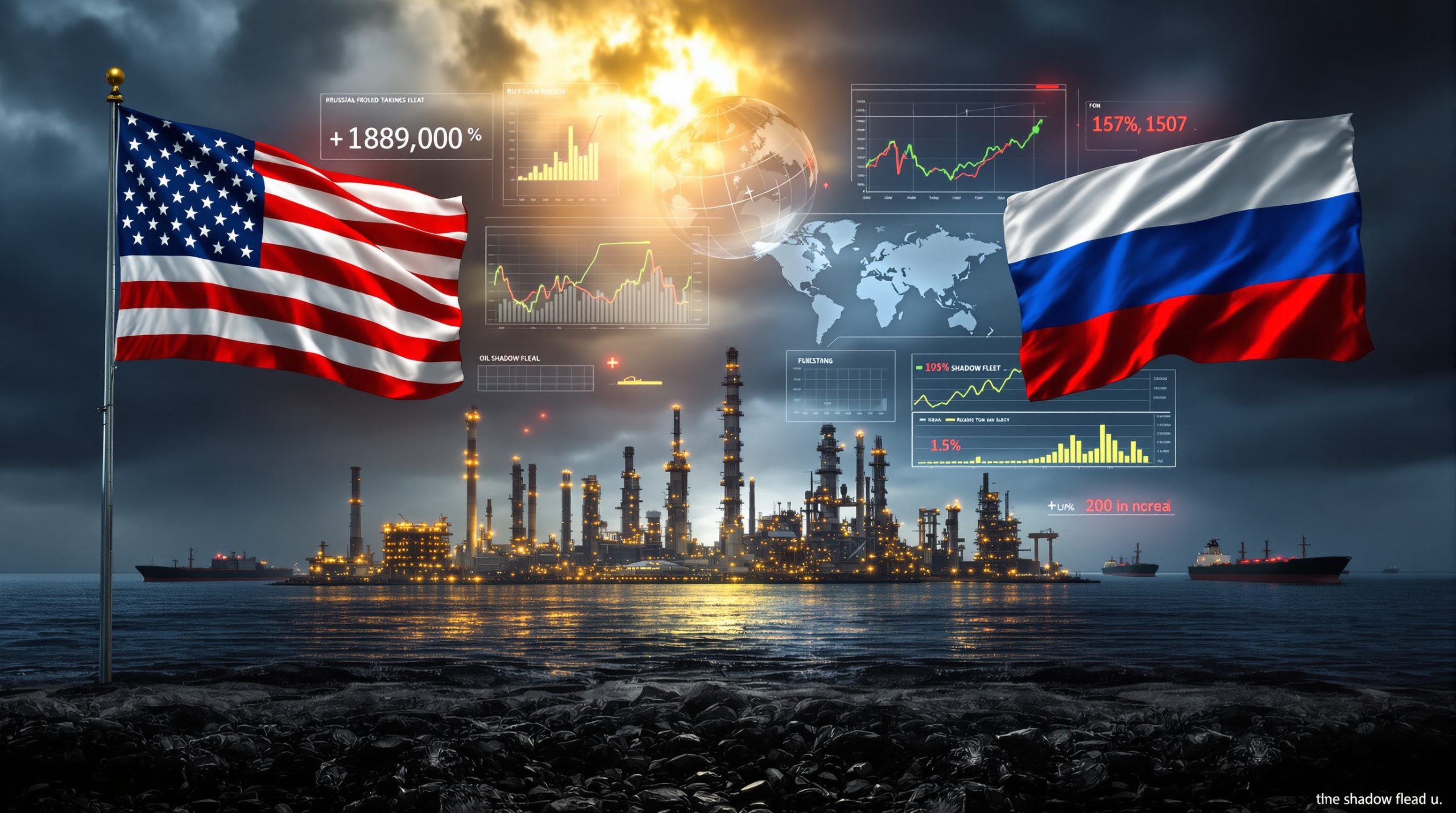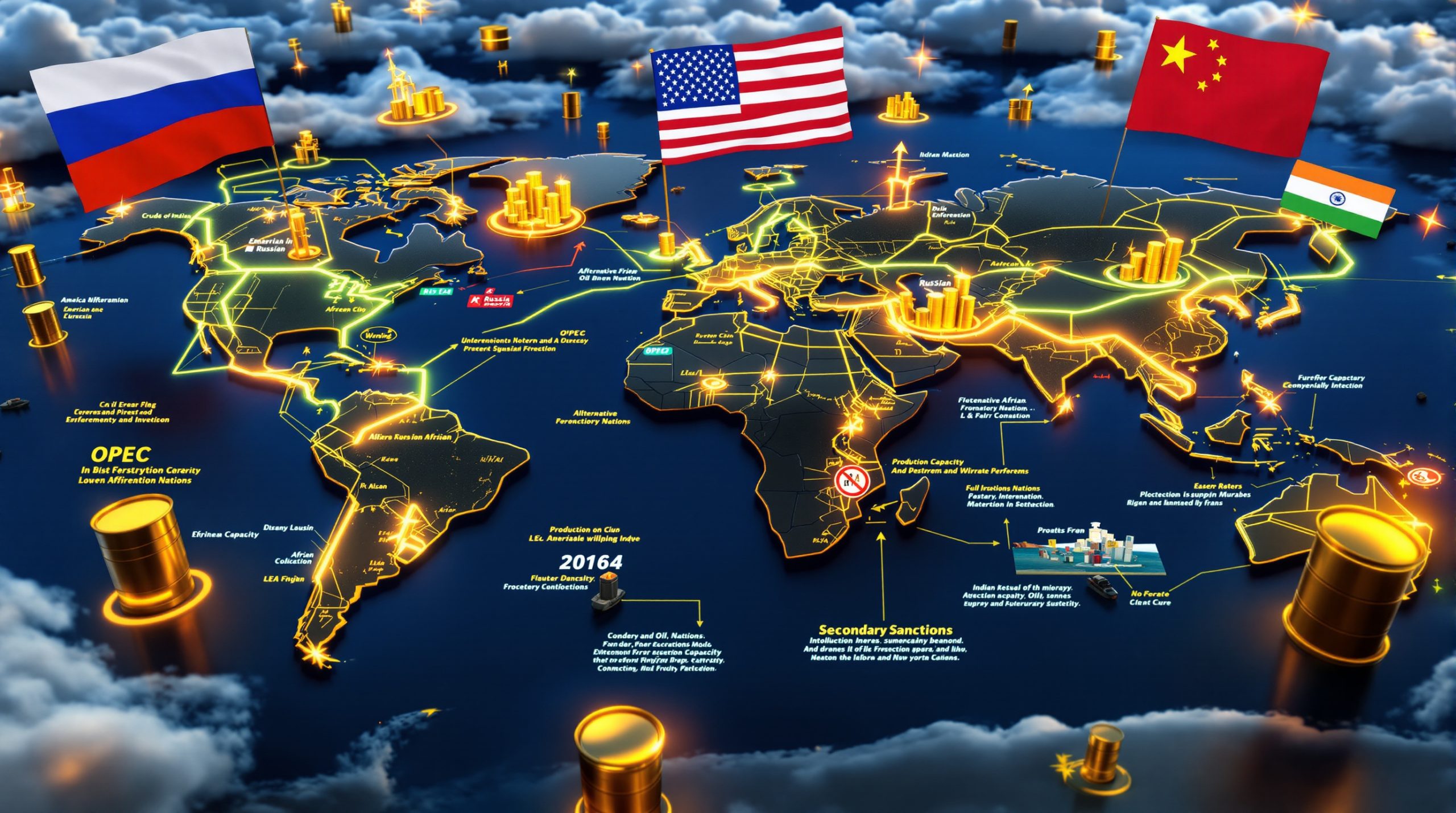How Is the World Economy Becoming Multi-Polar?
The global economic landscape is undergoing a profound transformation as we witness the decline of unipolar American dominance. This shift traces back to the 1945 Bretton Woods agreement that established the United States as the unquestioned global economic leader following World War II. However, with a debt-to-GDP ratio reaching 125% and fiscal deficits running at 7%, the United States can no longer afford to maintain its role as the primary supporter of the global trading and security environment.
This transition is analogous to parents who must eventually tell their adult children they can no longer financially support them. The United States is signaling to the world that it cannot continue to foot the bill for global economic stability while its own economic foundations weaken. We're moving from a unipolar world dominated by American interests to a multi-polar system where multiple powers exercise different types of military and economic influence.
The End of Unipolar American Dominance
The post-World War II economic order that positioned America at its center has reached its financial limits. The current global system, built on American military protection and economic leadership, requires a level of financial commitment that the United States can no longer sustain. With historical debt levels and persistent deficits, America faces the reality that it must rebalance its international commitments with domestic priorities.
The debates around NATO funding and America's implementation of tariffs aren't merely political posturing—they reflect fundamental economic realities. These developments signal that countries worldwide must begin defining new monetary systems, trading relationships, and security arrangements as American financial leadership recedes.
Structural Economic Challenges
The American standard of living has been in decline, creating significant pressure to reshape international economic relationships. This economic reality manifests in NATO funding debates, where the US increasingly demands greater contributions from European partners, and in tariff implementations aimed at protecting domestic industries and generating revenue.
Countries across the global economic spectrum now face the daunting task of redefining monetary systems, establishing new trading frameworks, and developing security arrangements that reflect the multi-polar reality. This transition period creates both challenges and opportunities as nations jockey for position in the emerging economic order.
What Do US Tariff Policies Really Mean?
American tariff policies are often misunderstood in the public discourse. Rather than viewing them simply as protectionist measures or political tools, a deeper historical and economic context reveals their strategic purpose in the emerging multi-polar economy.
Historical Context of American Tariffs
Alexander Hamilton, America's first Treasury Secretary, developed a sophisticated playbook for tariffs that served multiple purposes. His approach involved implementing moderate tariffs that simultaneously protected emerging American industries while generating government revenue. This balanced approach avoids the pitfalls of excessive protectionism while maintaining competitive advantages.
During the late 1800s, President William McKinley employed tariffs of 25-50% primarily as negotiation tools rather than permanent economic barriers. This historical precedent sheds light on the current administration's strategy, which combines revenue generation objectives with creating negotiation leverage in international trade discussions.
Misunderstandings About Automotive Tariffs
Current debates about automotive tariffs often miss the strategic intent behind them. The administration's focus isn't on blocking vehicle imports entirely but on developing domestic manufacturing capabilities for critical components—engines, transmissions, drivetrains, and differentials. The policy aims to ensure vehicles with over 50% US content can enter the market tariff-free.
Interestingly, the top five vehicles exported from Canada to the United States already contain these critical American components. For example, the Honda CR-V and similar models manufactured in Canada use engines and transmissions made in American factories. This explains why certain automotive tariffs are less disruptive to established supply chains than commonly believed.
Even US-assembled vehicles may face tariffs if they rely heavily on foreign components, underscoring that the policy targets content origin rather than simply assembly location. This nuanced approach aims to strengthen the entire automotive supply chain within American borders rather than just final assembly.
Economic Impact of Tariffs
Contrary to popular economic narratives, tariffs primarily slow economic growth rather than create inflation. They change relative prices within an economy—making imported goods more expensive relative to domestic alternatives—but don't necessarily increase the general price level across all goods and services.
This distinction explains why economists anticipate a potential "growth scare" in the United States rather than an inflation surge from tariff implementation. Meanwhile, Canada faces the risk of a "balance sheet recession" as its economy adapts to changing trade dynamics. Understanding these mechanisms helps clarify why Trump's policies are reshaping global commodity markets rather than merely serving as a political weapon.
How Are Central Banks Responding to Economic Changes?
Central banks around the world are navigating the transition to a multi-polar economic system through monetary policy adjustments. Their decisions reflect both domestic priorities and the changing global economic landscape.
Federal Reserve Policy Outlook
The current Federal Reserve funds rate stands at 4.33%, significantly above the natural rate of interest estimated at 2.75%. This gap indicates monetary policy remains restrictive despite easing inflation pressures. Market projections suggest rate cuts beginning in May or June 2024, potentially starting with a substantial 50 basis point reduction to signal a decisive policy shift.
Financial analysts project 4-5 rate cuts throughout 2024 as the Fed responds to slowing economic growth and normalized inflation metrics. However, it's crucial to understand that Fed rate decisions influence gold market volatility and take approximately two years to fully impact the broader economy, creating a significant lag between policy decisions and economic outcomes.
This delay mechanism explains why economic headwinds may persist even after rate cuts begin, as the effects of previous restrictive policy continue working through the system. The Fed's challenge lies in timing these cuts to avoid both unnecessary economic pain and premature stimulus that could reignite inflation.
Bank of Canada's Approach
The Bank of Canada has adopted a more aggressive rate-cutting approach than the Federal Reserve, reflecting Canada's distinct economic challenges and greater sensitivity to housing market dynamics. By mid-2027, the Bank of Canada's rates are expected to fall significantly below 2%, diverging from the Federal Reserve's projected 2% terminal rate in the same timeframe.
This policy divergence creates interesting cross-border investment dynamics and currency implications that savvy investors can leverage. The different approaches reflect how central banks in a multi-polar world economy increasingly tailor monetary policy to domestic conditions rather than following a single global leader's approach.
Inflation Expectations
Despite political rhetoric about persistent inflation, market-based measures show well-anchored inflation expectations. Five-year five-year forwards break-evens stand at 2.11%, below the Federal Reserve's 2.25% target. This indicator, which measures expected inflation rates five years from now for the following five-year period, provides a more reliable gauge than consumer surveys.
The University of Michigan survey data on inflation, often cited in political contexts, shows significant political bias in responses and has proven less reliable for monetary policy formulation than market-based measures. Central bankers increasingly rely on market signals and their own forecasting models rather than consumer sentiment surveys when determining inflation trajectories.
What Assets Will Perform Well in a Multi-Polar World?
The transition to a multi-polar economic system creates distinct investment opportunities across several asset classes. Understanding these dynamics helps investors position portfolios for the changing global landscape.
Store of Value Assets
Gold is projected to reach $5,000 per ounce by 2028, representing a substantial increase from current levels. This projection reflects gold's historical role during periods of monetary system transitions and geopolitical uncertainty. As a physical asset with limited annual supply growth (approximately 1.5%), gold market analysis suggests it provides a reliable hedge against currency debasement.
Silver, often described as "poor man's gold," offers similar store-of-value characteristics with additional industrial applications, particularly in green energy technologies. This dual utility makes silver an interesting asymmetric bet in the current environment.
Bitcoin represents another store-of-value alternative with what proponents describe as "perfect scarcity" due to its capped supply of 21 million coins. Unlike gold, which could theoretically face supply increases through improved mining techniques or asteroid mining, Bitcoin's supply remains mathematically fixed. This characteristic attracts investors seeking protection against monetary debasement in an increasingly uncertain world.
These assets benefit from three key factors in the current environment: lowering interest rates (which reduce the opportunity cost of holding non-yielding assets), declining confidence in leadership (increasing demand for assets outside traditional financial systems), and increased liquidity from central bank policies.
Technology and Innovation
Artificial intelligence represents perhaps the most significant investment opportunity of our generation, despite broader economic slowdowns. The current computing architecture transition from CPU-centric models (invented in 1947) to GPU-centric frameworks creates fundamental shifts in computing capabilities and corporate competitive advantages.
This technological revolution mirrors the internet's emergence in the 1990s, which faced similar skepticism before transforming the global economy. Technology companies now face an existential imperative to evolve their business models around AI capabilities or risk obsolescence as the computational paradigm shifts.
Companies developing specialized AI chips, providing essential infrastructure, or integrating AI capabilities into existing products and services will likely outperform regardless of broader economic conditions. This sector represents a rare growth opportunity amid potential economic headwinds.
Natural Resources
Countries with abundant natural resources are positioned to thrive in the emerging multi-polar world, particularly as AI development increases energy consumption requirements. Access to cheap, reliable energy will increasingly determine economic winners as computing power demands grow exponentially.
Canada possesses significant natural resource advantages with its abundant oil, natural gas, hydroelectric capacity, and uranium reserves. These resources could position Canada as an AI superpower if properly developed, as the country could offer some of the world's most affordable energy—a critical input for data centers and computational infrastructure.
Furthermore, China's economic stimulus benefits iron ore mining and other resource sectors, creating additional opportunities in the natural resource space. The countries that develop and leverage their natural resources efficiently will gain significant competitive advantages in the AI-driven economy, potentially reshaping global economic hierarchies based on energy production capabilities rather than traditional measures of economic development.
When Should Investors Be Concerned About Market Risks?
Understanding market cycle projections helps investors anticipate potential volatility and position their portfolios accordingly. The coming years present distinct risk profiles that require strategic planning.
Market Cycle Projections
For 2024, analysts project slower economic growth but not a full-scale recession. The most significant market risks appear concentrated in 2026, with potential for a 15-20% market drawdown—substantially exceeding the normal 8-10% annual market corrections that investors should expect.
Mid-term election years historically experience larger market corrections due to policy uncertainty and potential fiscal changes. This pattern seems likely to repeat as the multi-polar economic transition continues, creating both challenges and opportunities for prepared investors.
Despite these shorter-term risks, the long-term outlook remains positive with projections for a continued secular bull market as technological innovation drives productivity improvements. Distinguishing between cyclical corrections and secular trends helps investors maintain appropriate time horizons.
Psychological Market Processing
Current market sentiment remains dominated by fear despite rising prices, creating the classic "wall of worry" that bull markets typically climb. Following initial tariff implementation and as economic policy becomes clearer, market psychology will likely transition from fear toward greed—signaling a more advanced stage of the market cycle.
Historical data demonstrates that purchasing equities during 10% corrections yields average returns of 35% over the subsequent 12 months. This pattern underscores why maintaining discipline during volatile periods and using market corrections as buying opportunities typically rewards investors with superior long-term performance.
Understanding these psychological patterns provides investors with valuable context for interpreting market movements and maintaining appropriate investment discipline during periods of heightened volatility.
How Will the US Dollar System Evolve?
The global monetary system centered on the US dollar faces evolutionary pressures as the world becomes more multi-polar. This evolution creates both challenges and opportunities for investors.
Digital Transformation of Currency
Financial experts predict the emergence of a new digital global monetary system centered on regulated stablecoins and Bitcoin. This transition mirrors the 1970s shift when President Nixon closed the gold window and established the petrodollar system—a fundamental restructuring of global finance.
Stablecoins will likely be regulated similar to money market funds, backed by US dollars and treasuries to ensure stability and regulatory compliance. This evolution, rather than undermining the dollar system, could reinforce the US dollar and treasuries as global stores of value by expanding their utility in digital formats.
The integration of digital currencies into the traditional financial system represents a pragmatic adaptation to changing technology rather than a revolutionary overthrow of existing monetary frameworks. This gradual evolution provides multiple investment entry points as the system develops.
Declining Dollar Influence
The US dollar has experienced gradual decline since former President Trump's election, with corresponding increases in gold prices. This pattern reflects changing perceptions of American economic dominance and fiscal sustainability as debt levels increase.
Government spending as a percentage of GDP is expected to contract from the current 25% toward a more sustainable 19-20% range, reflecting fiscal pressures from rising debt servicing costs. This fiscal retrenchment will influence dollar valuation and global currency relationships as the new commodity super-cycle reshapes global supply chains and the multi-polar world develops.
Understanding these currency dynamics helps investors position their portfolios appropriately across domestic and international assets, particularly for those seeking to preserve purchasing power during monetary system transitions.
How Can Investors Navigate This Changing Landscape?
The transition to a multi-polar world economy requires thoughtful investment strategy adjustments to capitalize on emerging opportunities while managing increased volatility.
Investment Strategy Principles
Successful investors will focus on assets that benefit from a slowing economy while gaining from lower interest rates—a combination that favors certain sectors over others. They'll also target secular growth opportunities in technology, healthcare, and energy that can thrive despite economic headwinds.
Demographic shifts fundamentally alter investment patterns as millennials and younger investors increasingly favor ETFs and cryptocurrencies over traditional investment vehicles like mutual funds. These preference changes drive capital flows and influence asset valuations across markets.
Understanding market volatility patterns allows investors to use corrections as buying opportunities rather than sources of panic. This approach requires both psychological discipline and sufficient liquidity to deploy during market dislocations.
Risk Management Approaches
The store-of-value thesis offers multiple implementation options with varying risk profiles. Gold provides lower volatility exposure suitable for conservative investors seeking inflation protection without significant price swings. Bitcoin represents a medium volatility option with higher potential returns but corresponding risk. Companies like MicroStrategy offer the highest volatility exposure to this thesis through their significant Bitcoin holdings.
Investors should choose their exposure levels based on personal risk tolerance, investment time horizons, and portfolio diversification needs. This tiered approach allows participation in the store-of-value thesis without exceeding individual risk parameters.
What Does This Mean for Canada's Future?
Canada faces both significant challenges and opportunities as the multipolar world economy develops. According to the World Economic Forum, its economic future depends on crucial policy decisions regarding resource development and economic diversification.
Economic Transformation Needed
Canada's economy has become overly dependent on real estate, creating vulnerability to interest rate fluctuations and housing market corrections. This overconcentration has come at the expense of developing the country's abundant natural resources, limiting economic potential and resilience.
The country faces declining standards of living, productivity challenges, and reduced private investment per worker—trends that require structural adjustment regardless of climate policy perspectives. These economic realities create pressures for policy reconsideration as global competition intensifies.
Opportunity in Natural Resources
Canada possesses the natural resources required to become an artificial intelligence superpower through cheap energy development. Its natural gas, oil, hydroelectric power, and uranium reserves represent significant competitive advantages in an increasingly energy-hungry computational world.
The country faces a national decision about resource development that will determine whether its standard of living continues declining or reverses course through strategic investment. This choice transcends traditional political divisions and speaks to fundamental economic realities in the emerging multi-polar landscape.
FAQs About the Multi-Polar World Economy
What is causing the shift to a multi-polar world economy?
The United States can no longer afford to support the global trading and security environment with its unsustainable debt-to-GDP ratio of
125% and fiscal deficits running at 7%. This economic reality is forcing a redistribution of global economic and military power among multiple nations as America rebalances its international commitments.
Are tariffs inflationary for the US economy?
No, tariffs change relative prices within an economy but don't typically increase the general price level across all goods and services. They tend to slow economic growth rather than create inflation, which is why economists anticipate a "growth scare" rather than an inflation surge from tariff implementation.
How will gold and Bitcoin perform in this environment?
Both assets are expected to perform well, with gold potentially reaching $5,000 per ounce by 2028. Bitcoin offers mathematically guaranteed scarcity compared to gold's potential supply increases but with higher volatility. Both benefit from falling interest rates, declining confidence in traditional systems, and increased liquidity.
When will the Federal Reserve begin cutting interest rates?
Rate cuts are projected to begin in May or June 2024, possibly starting with a 50 basis point reduction. Analysts anticipate 4-5 rate cuts throughout 2024, though the full economic impact won't be felt for approximately two years due to monetary policy transmission lags.
What investment opportunities exist in this changing environment?
The most promising opportunities include store-of-value
Ready to Act on Major Mineral Discoveries Before the Market?
Discover how to gain a significant advantage with Discovery Alert's proprietary Discovery IQ model, providing instant, real-time notifications of major ASX mineral discoveries as they happen. Visit the Discovery Alert discoveries page to understand why historical discoveries have generated remarkable returns and start your 30-day free trial today.




